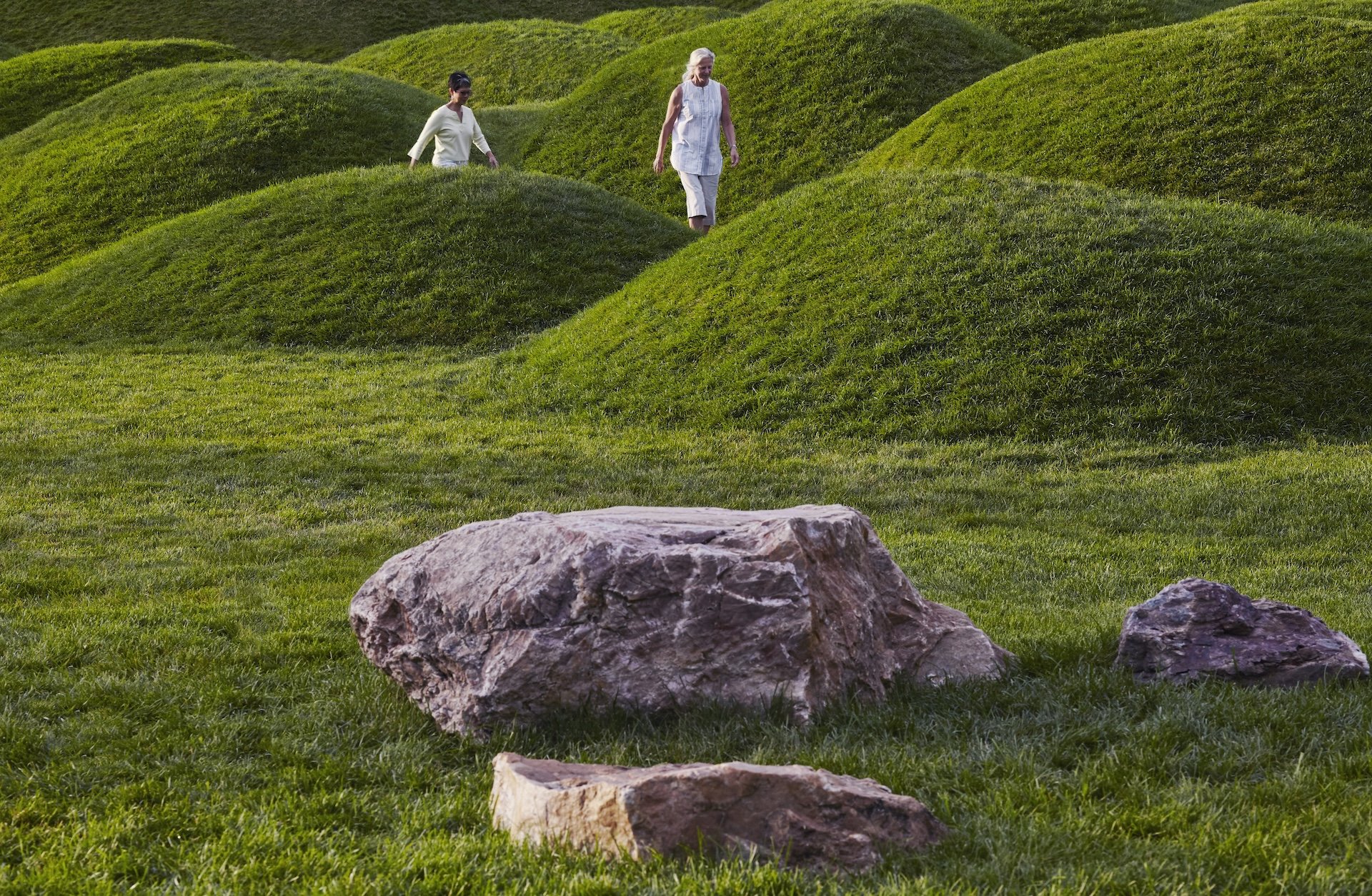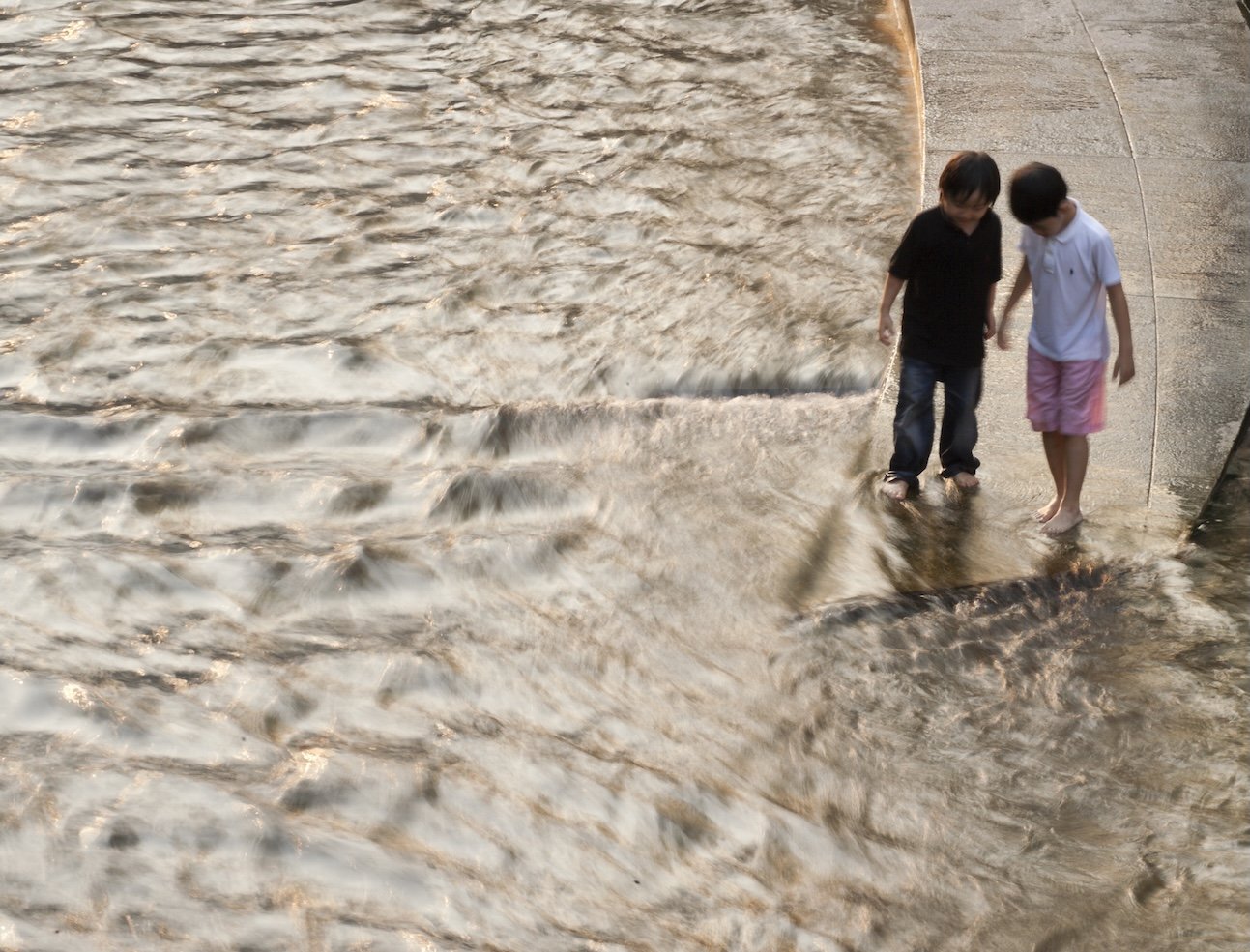
One afternoon, when Mikyoung Kim was a teenager, she sat on the bench before her piano. Her architect father and ceramicist mother, both recent immigrants to America from South Korea, had taken out a loan to purchase the instrument when she was 5, and she’d practiced intensely every day since.
Her body became a right angle enfolding the form of the piano, her fingers forming more angles across its keys. Kim looked at the score, the black-and-white blueprint of dots and lines she could turn into sound. In fact, she heard what she saw. She closed her eyes and began to play. Her piano teacher told her to play it lighter: Play it as if you’re walking across a winter field, with a very light crust on top of the snow.
The sound of Kim remembering this moment fills the Boston conference room of her namesake landscape architecture firm, which she founded in 1994 and which has since gathered a crescendo of award-winning projects around the world, from South Korea to Detroit to down the block from her office, all these decades later. For Kim, it was a moment in which an imagined landscape became a manifestation of the connection between sight, sound, and emotion, a bridge she could create. She was a gifted player, who followed high school with acceptance into the prestigious Oberlin Conservatory of Music. Plans of further development collapsed when she developed tendinitis in her left arm. “It was so traumatic,” she says, her tone still wincing. Even the lightest walk across the snow’s crust was too much to bear.
So Kim turned to sculpture, then to landscape architecture, at the Harvard Graduate School of Design, and to public art, at MIT. But she couldn’t get sound out of her head. “It was shocking to me how visually oriented landscape architects and designers are,” she says. “When we think about noise, we think of loud noises affecting the structural component of your ear—of losing your hearing. But it’s a much deeper thing. My journey was to understand how sound actually affects us. It should be an important part of how we design anything.”
Kim sees noise as a vital yet under-explored subject that, thanks to technological innovation, is constantly changing, impacting our spaces and our selves. Although the connections between human and environmental health have been clearly demonstrated, they are rarely prioritized by architects in the design process. By developing work, research, and tools that address all things aural as it pertains to building—funded in part by grants from the Landscape Architecture Foundation—Kim broadcasts a call to action: Architects need to start thinking about how spaces sound.

It’s worth remembering why we hear. “Our sense of hearing evolved to keep track of things that our eyes are not pointed at,” says Carl Giegold, a partner at Threshold Acoustics who has contributed to the Veterans Administration’s guidelines for healing environments. “Typically, an urban environment, like a streetscape, is ‘safe’ as defined by our sense of sight. But it’s incredibly dangerous from the standpoint of our sense of hearing, because the din of the city masks those little events that our brains are programmed to seek out.” Walking down a hallway or park path that’s designed with only visual aesthetics in mind might in fact be a stressful cacophony as our ears struggle to sort through the noise.
What we hear has real health costs: Researchers at the nearby Massachusetts General Hospital and Mass General have found links between transportation noise and the stress pathways that increase the risk of cardiovascular and metabolic diseases. Ongoing exposure to urban din in Europe has been linked to 50,000 new cases of heart disease annually; the European Environmental Agency has ruled that only air pollution is a greater environmental danger to public health.
And how much we hear matters, too. At the American Society of Landscape Architects’ recent Conference on Landscape Architecture, Giegold presented “Sound and the City,” a session about the impacts of urban noise pollution on health, with members of Kim’s team, and how to implement “sound-conscious design in neuro-inclusive landscape architecture.”
“We’ve found that noise pollution impairs our health and well-being both neurologically and physiologically,” says Henry Lyon, a former director at Kim’s firm, which has spent decades researching and collaborating with neurodiversity experts and designers. “Hypersensitivity to sound is common to many psychological conditions, including autism spectrum disorders, schizophrenia, PTSD, anxiety, and depression.”
As the global population increasingly urbanizes, the threat of noise pollution grows. “It’s profoundly unhealthy, profounding stressful,” Giegold says of the sounds. “It’s a failing of architecture to live exclusively in the visual realm, in the composition for the eye, without thinking of what it’s doing to the whole human.”

“There’s something about listening that’s so bodily,” says Shannon R. Stratton, who, as the former chief curator at New York’s Museum of Arts and Design, installed exhibitions, including “Atmosphere for Enjoyment: Harry Bertoia’s Environment for Sound” and “Sonic Arcade: Shaping Space with Sound,” that explored how the auditory and the visual can make meaning in architecture. Whether visitors played or listened to the works on view, she was surprised at the effect: people slowed down and let their bodies linger. They listened longer than the average visitor looked. “Maybe listening activates a patience that looking doesn’t, anymore,” Stratton says. Sound, when deployed attractively, can itself become an attraction.
Kim is similarly rethinking the aural experience for people in a different realm: health care. There, as with most of her work, she isn’t just interested in reducing the negative effects of sound, but in harnessing its positive aspects, too. In 2018, she completed the first movement of what’s become an ongoing symphony of environmentally sensitive master planning at Boston Children’s Hospital: a redesigned entry with generous streetscapes and warm, wood furniture curving like welcoming hands; interstitial spaces with waves of walls that create quiet nooks to chat, think, or rest; and a crucial quartet of “healing gardens” that not only dampen the clamor of the city and hospital, but create distinct sonic surroundings that aid in recovery.
“You don’t go to a children’s hospital just for a shot,” Kim says. “It’s often the worst day of your life.” Patients told her of entering the complex and not being able to leave for years. “The first thing they always talked about was getting rid of the sounds of their room, that beep-beep-beep that notifies caregivers that something is happening. They want a sonic oasis. And they want to see the sky.”
Any rooftop garden worth its soil will accomplish the latter. But Kim wanted to make the gardens places patients will not just escape to, but escape in, which required more than silence. “Most acoustic engineers are focussed on mitigation,” she says. So was she, particularly in designing the hospital’s End of Life Garden, which offers areas blanketed by layers of different plants and simple furnishings that can be cloistered off and reserved for families. “You’re really protected, sonically,” she says, at a moment when you might need it most.

When designers begin on a project, they typically conduct studies on shade, soil, and wind—but rarely on sound. With Giegold, Kim is creating an assessment tool kit to change that. It involves using AudioMoth, an inexpensive open-source acoustic monitoring device, to determine what kind of noise is present, followed up by onsite recordings made by Decibel, a sound-level meter app.
The results identify how much sound is in need of mitigation, like street and mechanical, electrical, and plumbing hubbub, and when and where on the site they’re most prominent. “Master planning and zoning regulations could require [things like] soft materials on façades, or green walls and façade geometries that push sound up and out of the way,” Giegold says.
They’re also assembling small-scale, long-term ways to reduce unwanted noise, such as specifying certain materials and products, and recommendations for site planning and maintenance: Fescue and clover mixes could replace traditional lawns, for instance, and only need to be mowed two times a year; electric leaf blowers could be used in lieu of gas-powered landscaping equipment. Meanwhile, the team identifies practical ways to introduce sounds they want to encourage, including birds, breeze, and the babbling of rivers. “A roof cap can be a little sound sculpture,” Giegold says. “It can be that simple.” And that profound.
In effect, Kim and her team are seeking new industry standards, where firms will use the tool kit in their own designs. The value of having those tools echoes through her firm’s projects, regardless of their scale. Consider the 37-acre public TMC Helix Park in Houston, which sets more than 650 trees and heat-reflecting pathways that twist like DNA around a medical center and above a floodplain near the Brays Bayou. Built from the ground up, the park incorporates multiple typologies of sound, all related to the water that defines the region. At the entrance, the benches—made of wood, for maximum sound resonance—ring around one of the waterfalls that feed the park’s river, which is itself a sound source, its murmur manipulated like a bow on a string by the texture of the riverbed. Kim spent months CNC-routing models to determine the proper thickness.
This is not the first time she’s dealt with rivers: In 2007, she completed a pedestrian plaza along the Cheonggye River in central Seoul, situated below street level, in part, because of stormwater management. But “sonically,” Kim says, “it protects you from the streets.”
Compositions like these seek to harmonize acoustic considerations with visual and structural ones. They value natural sound as much as natural light. For Kim, it could be a park in the middle of the city that offers auditory paths as well as architectural ones—and that understands how the two might become one, as canopies of trees announce the forming of a new space with their dappling of light and rustling in the wind. Or it could be a garden for a kid who can’t leave the hospital, but whose well-being deserves the pleasures of birdsong, rippling water, perhaps even the crackle of a foot dancing across the ice. “We’re trying to think,” Kim says, her voice softening, “about the music of landscape.”